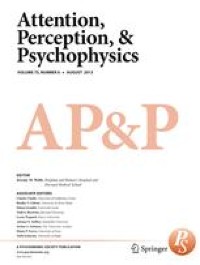Abstract
What we pay attention to in the visual environment is often driven by what we know about the world. For example, a number of studies have found that observers can adopt attentional sets for a particular semantic category. However, some objects are more typical members of a category than others. While previous evidence suggests that an object's typicality can influence the guidance of attention in visual search, it is unclear whether typicality can also influence the capture of attention. To test whether this is the case, participants were given a category of objects at the beginning of each trial. Then, a rapid serial visual presentation (RSVP) stream was presented at fixation, and participants had to indicate whether an object of the given category was present or absent from the stream. Importantly, a single flanker image also appeared above or below the central stream just before the target. This flanker could belong either to the same category as the target or a different category, and could be a typical or atypical exemplar of that category. Participants were less accurate at detecting the target when the flanker belonged to the same category as the target. Moreover, participants were even less accurate when the flanker was a typical exemplar of this category. Similar findings were observed when targets consisted of typical and atypical exemplars. Together, these findings indicate that the extent of attentional capture toward a distractor depends on whether the distractor matches the category and typicality of one's attentional set.



No comments:
Post a Comment